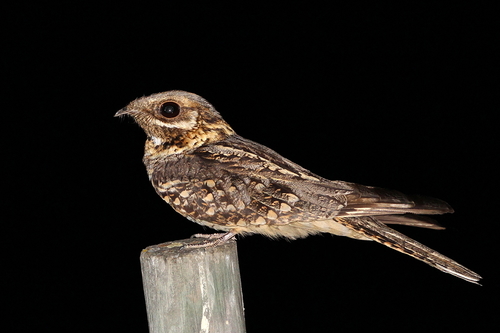
Red-necked Nightjar
The Red-necked Nightjar (*Caprimulgus ruficollis*) is a captivating nocturnal bird species known for its cryptic plumage and distinctive calls. It plays a crucial role in controlling insect populations within its ecosystem. While not globally threatened, this species faces increasing pressure from habitat loss and other anthropogenic factors. This nightjar holds a place in local folklore in some regions, often associated with dusk and the transition to night.
25-29 cm
Length
55-65 cm
Wingspan
Least Concern
Conservation Status
Distribution
The Red-necked Nightjar breeds in the Iberian Peninsula (Spain and Portugal) and Northwest Africa (Morocco, Algeria, Tunisia). It migrates to spend the non-breeding season in sub-Saharan West Africa.
Lifespan
Up to 8 years (wild); data limited.
Red-necked Nightjar's Habitat
Habitat Types
Open woodlands, Scrubland, Heathland, Semi-arid areas with scattered trees
Climate Zones
Mediterranean, Temperate, Semi-arid
Adaptations
Their cryptic plumage provides excellent camouflage during the day, allowing them to roost on the ground or in low vegetation with minimal risk of detection. They are adapted for crepuscular and nocturnal activity, with large eyes for enhanced vision in low light.
Variations
Two subspecies are generally recognized: *C. r. ruficollis* in the Iberian Peninsula and *C. r. desertorum* in North Africa, the latter often paler.
Appearance
Breeding Plumage
Subtle differences; breeding plumage may have slightly more vibrant rufous tones on the neck.
Seasonal Feather Changes
Minimal seasonal variation.
Sex Based Plumage Differences
Males have small white spots on the wings and tail, which are less prominent or absent in females.
Notable Features
Rufous collar around the neck (more prominent in males), Cryptic, mottled brown, grey, and black plumage, Large, dark eyes, Small bill with wide gape
Diet and Feeding
Primary Foods
Moths, Beetles, Other flying insects
Foraging Behavior
The Red-necked Nightjar is an aerial insectivore, catching prey on the wing. It typically forages at dusk and dawn, and during the night, often flying low over open ground or near vegetation.
Specializations
The wide gape and rictal bristles (stiff hair-like feathers around the bill) help to funnel insects into the mouth.
Seasonal Diet Variations
Diet composition likely varies depending on insect availability throughout the year and across its breeding and non-breeding ranges.
Behavior
Social Structure
Generally solitary or found in pairs during the breeding season. May form small, loose groups during migration.
Communication
A distinctive, repetitive 'kyok-kyok-kyok...' call, often uttered in flight., Wing-clapping during courtship displays., Soft churring calls near the nest.
Migration
A migratory species, traveling between breeding grounds in Europe and North Africa and non-breeding areas in West Africa. Migration is nocturnal.
Territorial or Group Behaviors
Males are territorial during the breeding season, defending their nesting area from rivals.
Conservation
Threats
Habitat loss and degradation due to agricultural intensification, Use of pesticides, reducing insect prey availability, Road mortality during migration, Climate change
Protection Programs
Some protection through habitat conservation within protected areas., EU Birds Directive Annex I species.
Local National Laws
Protected under national legislation in several European and North African countries.
Population Trend
Decreasing
Population Estimates
Global population estimated to be between 101,000-499,999 individuals.
Interesting Facts
They are highly camouflaged.
Their cryptic plumage makes them incredibly difficult to spot when roosting during the day.
They are masters of nocturnal flight.
They are agile fliers, able to maneuver swiftly to catch insects in the dark.
They have special bristles to help them capture food.
Rictal bristles around the bill help them to funnel insects during flight.
Faqs about Red-necked Nightjar
What does a Red-necked Nightjar sound like?
Its most common call is a repetitive, mechanical-sounding 'kyok-kyok-kyok...'.
Where can I see a Red-necked Nightjar?
They are most easily observed at dusk or dawn in open woodlands or scrubland within their breeding range (Iberian Peninsula and Northwest Africa) during the summer months.
Are Red-necked Nightjars endangered?
They are currently classified as Least Concern by the IUCN, but their population is declining.
Copyright @ Nature Style Limited. All Rights Reserved.
 English
English